Detecting the Effects of Extreme Events on Estuarine Suspended Particulate Matter Using Satellite Remote Sensing (Scheldt Estuary): Challenges and Opportunities
Abstract
1. Introduction
2. Materials and Methods
2.1. Study Site
2.2. In Situ Data
2.3. Remote Sensing Data and Validation of SPM Products
2.4. Data Analysis
3. Results
3.1. Validation of SPM Products
3.2. Description and Context of Estuarine Drivers during SPM Data Acquisition
3.3. Spatial Relationships of River Discharge and Wind Speed with SPM
4. Discussion
4.1. Assessing Estuarine SPM Concentrations from Landsat Satellite Sensors
4.2. SPM Variability from Interaction with Estuarine Forcing Mechanisms and Its Limitations
4.3. Effects of Extreme Events on SPM
4.4. Transferable Lessons and Opportunities to Monitor SPM in Extreme Events
5. Conclusions
Supplementary Materials
Author Contributions
Funding
Data Availability Statement
Acknowledgments
Conflicts of Interest
References
- Stall, J.B. Effects of Sediment on Water Quality. J. Environ. Qual. 1972, 1, 353–360. [Google Scholar] [CrossRef]
- Olsen, C.R.; Larsen, I.L.; Mulholland, P.J.; Von Damm, K.L.; Grebmeier, J.; Schaffner, L.C.; Diaz, R.J.; Nichols, M.M. The Concept of an Equilibrium Surface Applied to Particle Sources and Contaminant Distributions in Estuarine Sediments. Estuaries 1993, 16, 683–696. [Google Scholar] [CrossRef]
- IOCCG. Uncertainties in Ocean Colour Remote Sensing; Mélin, F., Ed.; Report Serie; International Ocean Color Coordinating Group: Dartmouth, NS, Canada, 2019; ISBN 9780415475976. [Google Scholar]
- Wetsteyn, L.P.M.J.; Kromkamp, J.C. Turbidity, Nutrients and Phytoplankton Primary Production in the Oosterschelde (The Netherlands) before, during and after a Large-Scale Coastal Engineering Project (1980–1990). Hydrobiologia 1994, 282–283, 61–78. [Google Scholar] [CrossRef]
- Schallenberg, M.; Burns, C.W. Effects of Sediment Resuspension on Phytoplankton Production: Teasing Apart the Influences of Light, Nutrients and Algal Entrainment. Freshw. Biol. 2004, 49, 143–159. [Google Scholar] [CrossRef]
- Harrison, E.; Norris, R.; Wilkinson, S. The Impact of Fine Sediment Accumulation on Benthic Macroinvertebrates: Implications for River Management. In Proceedings of the 5th Australian Stream Management Conference, Albury, NSW, Australia, 21–25 May 2007; pp. 139–144. [Google Scholar]
- Meire, P.; Ysebaert, T.; Van Damme, S.; Van Den Bergh, E.; Maris, T.; Struyf, E. The Scheldt Estuary: A Description of a Changing Ecosystem. Hydrobiologia 2005, 540, 1–11. [Google Scholar] [CrossRef]
- Fettweis, M.; Sas, M.; Monbaliu, J. Seasonal, Neap-Spring and Tidal Variation of Cohesive Sediment Concentration in the Scheldt Estuary, Belgium. Estuar. Coast. Shelf Sci. 1998, 47, 21–36. [Google Scholar] [CrossRef]
- Doxaran, D.; Ruddick, K.; McKee, D.; Gentili, B.; Tailliez, D.; Chami, M.; Babin, M. Spectral Variations of Light Scattering by Marine Particles in Coastal Waters, from Visible to near Infrared. Limnol. Oceanogr. 2009, 54, 1257–1271. [Google Scholar] [CrossRef]
- Constantin, S.; Doxaran, D.; Derkacheva, A.; Novoa, S.; Lavigne, H. Multi-Temporal Dynamics of Suspended Particulate Matter in a Macro-Tidal River Plume (the Gironde) as Observed by Satellite Data. Estuar. Coast. Shelf Sci. 2018, 202, 172–184. [Google Scholar] [CrossRef]
- Mulligan, R.P.; Smith, P.C.; Tao, J.; Hill, P.S. Wind-Wave and Tidally Driven Sediment Resuspension in a Macrotidal Basin. Estuaries Coasts 2019, 42, 641–654. [Google Scholar] [CrossRef]
- Andutta, F.P.; Wang, X.H.; Li, L.; Williams, D. Hydrodynamics and Sediment Transport in a Macro-Tidal Estuary: Darwin Harbour, Australia. In Estuaries of Australia in 2050 and Beyond; Springer: Dordrecht, The Netherlands, 2014; pp. 111–129. [Google Scholar] [CrossRef]
- Seneviratne, S.I.; Nicholls, N.; Easterling, D.; Goodess, C.M.; Kanae, S.; Kossin, J.; Luo, Y.; Marengo, J.; Mc Innes, K.; Rahimi, M.; et al. Changes in Climate Extremes and Their Impacts on the Natural Physical Environment. In Managing the Risks of Extreme Events and Disasters to Advance Climate Change Adaptation: Special Report of the Intergovernmental Panel on Climate Change; Field, C.B., Barros, V., Stocker, T.F., Qin, D., Dokken, D.J., Ebi, K.L., Mastrandrea, M.D., Mach, K.J., Plattner, G.-K., Allen, S.K., et al., Eds.; Cambridge University Press: Cambridge, UK; New York, NY, USA, 2012; Volume 9781107025, pp. 109–230. ISBN 9781139177245. [Google Scholar]
- Scavia, D.; Field, J.C.; Boesch, D.F.; Buddemeier, R.W.; Burkett, V.; Cayan, D.R.; Fogarty, M.; Harwell, M.A.; Howarth, R.W.; Mason, C.; et al. Climate Change Impacts on U.S. Coastal and Marine Ecosystems. Estuaries 2002, 25, 149–164. [Google Scholar] [CrossRef]
- Paerl, H.W. Assessing and Managing Nutrient-Enhanced Eutrophication in Estuarine and Coastal Waters: Interactive Effects of Human and Climatic Perturbations. Ecol. Eng. 2006, 26, 40–54. [Google Scholar] [CrossRef]
- Dogliotti, A.I.; Ruddick, K.; Guerrero, R. Seasonal and Inter-Annual Turbidity Variability in the RíO de La Plata from 15 Years of MODIS: El NiñO Dilution Effect. Estuar. Coast. Shelf Sci. 2016, 182, 27–39. [Google Scholar] [CrossRef]
- Stanev, E.V.; Brink-Spalink, G.; Wolff, J.O. Sediment Dynamics in Tidally Dominated Environments Controlled by Transport and Turbulence: A Case Study for the East Frisian Wadden Sea. J. Geophys. Res. Oceans 2007, 112, 1–20. [Google Scholar] [CrossRef]
- van Kessel, T.; Vanlede, J.; de Kok, J. Development of a Mud Transport Model for the Scheldt Estuary. Cont. Shelf Res. 2011, 31, S165–S181. [Google Scholar] [CrossRef]
- van Maren, D.S.; Winterwerp, J.C.; Vroom, J. Fine Sediment Transport into the Hyper-Turbid Lower Ems River: The Role of Channel Deepening and Sediment-Induced Drag Reduction. Ocean Dyn. 2015, 65, 589–605. [Google Scholar] [CrossRef]
- Chen, M.S.; Wartel, S.; Van Eck, B.; Van Maldegem, D. Suspended Matter in the Scheldt Estuary. Hydrobiologia 2005, 540, 79–104. [Google Scholar] [CrossRef]
- Cox, T.J.S.; Maris, T.; Van Engeland, T.; Soetaert, K.; Meire, P. Critical Transitions in Suspended Sediment Dynamics in a Temperate Meso-Tidal Estuary. Sci. Rep. 2019, 9, 12745. [Google Scholar] [CrossRef] [PubMed]
- Doxaran, D.; Froidefond, J.; Castaing, P. Remote-Sensing Reflectance of Turbid Sediment-Dominated Waters. Reduction of Sediment Type Variations and Changing Illumination Conditions Effects by Use of Reflectance Ratios. Appl. Opt. 2003, 42, 2623–2634. [Google Scholar] [CrossRef] [PubMed]
- Eleveld, M.A.; van der Wal, D.; Van Kessel, T. Estuarine Suspended Particulate Matter Concentrations from Sun-Synchronous Satellite Remote Sensing: Tidal and Meteorological Effects and Biases. Remote Sens. Environ. 2014, 143, 204–215. [Google Scholar] [CrossRef]
- Normandin, C.; Lubac, B.; Sottolichio, A.; Frappart, F.; Ygorra, B.; Marieu, V. Analysis of Suspended Sediment Variability in a Large Highly Turbid Estuary Using a 5-Year-Long Remotely Sensed Data Archive at High Resolution. J. Geophys. Res. Oceans 2019, 124, 2019JC015417. [Google Scholar] [CrossRef]
- van der Wal, D.; Forster, R.M.; Rossi, F.; Hummel, H.; Ysebaert, T.; Roose, F.; Herman, P.M.J. Ecological Evaluation of an Experimental Beneficial Use Scheme for Dredged Sediment Disposal in Shallow Tidal Waters. Mar. Pollut. Bull. 2011, 62, 99–108. [Google Scholar] [CrossRef] [PubMed]
- Vet, P.L.M.; Prooijen, B.C.; Colosimo, I.; Ysebaert, T.; Herman, P.M.J.; Wang, Z.B. Sediment Disposals in Estuarine Channels Alter the Eco-Morphology of Intertidal Flats. J. Geophys. Res. Earth Surf. 2020, 125, e2019JF005432. [Google Scholar] [CrossRef]
- Verlaan, P.A.J. Marine vs Fluvial Bottom Mud in the Scheldt Estuary. Estuar. Coast. Shelf Sci. 2000, 50, 627–638. [Google Scholar] [CrossRef]
- Lee, B.J.; Fettweis, M.; Toorman, E.; Wang, J. Multimodal Particle Size Distribution in a Coastal Zone. In Proceedings of the Abstract of 11th International Conference on Cohesive Sediment Transport Processes (INTERCOH XI), Shanghai, China, 18–21 October 2011; p. 2. [Google Scholar]
- Manning, A.J.; Van Kessel, T.; Melotte, J.; Sas, M.; Winterwerp, H.; Pidduck, E.L. On the Consequence of a New Tidal Dock on the Sedimentation Regime in the Antwerpen Area of the Lower Sea Scheldt. Cont. Shelf Res. 2011, 31, S150–S164. [Google Scholar] [CrossRef]
- Manning, A.J.; Martens, C.; De Mulder, T.; Vanlede, J.; Winterwerp, J.C.; Ganderton, P.; Graham, G.W. Mud Floc Observations in the Turbidity Maximum Zone of the Scheldt Estuary during Neap Tides. In Journal of Coastal Research, SI 50 (Proceedings of the 9th International Coastal Symposium), Gold Coast, Australia, 25–29 April 2007; Coastal Education & Research Foundation, Inc.: Coconut Creek, FL, USA, 2007; pp. 832–836. [Google Scholar]
- Fettweis, M.; Van den Eynde, D. The Mud Deposits and the High Turbidity in the Belgian–Dutch Coastal Zone, Southern Bight of the North Sea. Cont. Shelf Res. 2003, 23, 669–691. [Google Scholar] [CrossRef]
- Gerrtisen, H.; Wang, Z.B.; van der Weck, A. Morfologische Interpretatie Can de Veranderingen in Het Getij van de Westerchelde; Report Z2671; Deltares (WL): Delft, The Netherlands, 1999. [Google Scholar]
- Allen, G.P.; Salomon, J.C.; Bassoullet, P.; Du Penhoat, Y.; de Grandpré, C. Effects of Tides on Mixing and Suspended Sediment Transport in Macrotidal Estuaries. Sediment. Geol. 1980, 26, 69–90. [Google Scholar] [CrossRef]
- Baeyens, W.; Van Eck, B.; Lambert, C.; Wollast, R.; Goeyens, L. General Description of the Scheldt Estuary. Hydrobiologia 1997, 366, 1–14. [Google Scholar] [CrossRef]
- Baeye, M.; Fettweis, M.; Voulgaris, G.; Van Lancker, V. Sediment Mobility in Response to Tidal and Wind-Driven Flows along the Belgian Inner Shelf, Southern North Sea. Ocean Dyn. 2011, 61, 611–622. [Google Scholar] [CrossRef]
- Sistermans, P.; Nieuwenhuis, O. Western Scheldt Estuary (the Netherlands). Eurosion Case Study 2004, 31, 1–14. [Google Scholar]
- Soetaert, K.; Middelburg, J.J.; Heip, C.; Meire, P.; Van Damme, S.; Maris, T. Long-Term Change in Dissolved Inorganic Nutrients in the Heterotrophic Scheldt Estuary (Belgium, The Netherlands). Limnol. Oceanogr. 2006, 51, 409–423. [Google Scholar] [CrossRef]
- Vanhellemont, Q.; Ruddick, K. Atmospheric Correction of Metre-Scale Optical Satellite Data for Inland and Coastal Water Applications. Remote Sens. Environ. 2018, 216, 586–597. [Google Scholar] [CrossRef]
- Vanhellemont, Q. Adaptation of the Dark Spectrum Fitting Atmospheric Correction for Aquatic Applications of the Landsat and Sentinel-2 Archives. Remote Sens. Environ. 2019, 225, 175–192. [Google Scholar] [CrossRef]
- Nechad, B.; Ruddick, K.G.; Park, Y. Calibration and Validation of a Generic Multisensor Algorithm for Mapping of Total Suspended Matter in Turbid Waters. Remote Sens. Environ. 2010, 114, 854–866. [Google Scholar] [CrossRef]
- Luo, Y.; Doxaran, D.; Ruddick, K.; Shen, F.; Gentili, B.; Yan, L.; Huang, H. Saturation of Water Reflectance in Extremely Turbid Media Based on Field Measurements, Satellite Data and Bio-Optical Modelling. Opt. Express 2018, 26, 10435. [Google Scholar] [CrossRef] [PubMed]
- Bailey, S.W.; Werdell, P.J. A Multi-Sensor Approach for the on-Orbit Validation of Ocean Color Satellite Data Products. Remote Sens. Environ. 2006, 102, 12–23. [Google Scholar] [CrossRef]
- Laws, E. Mathematical Methods for Oceanographers: An Introduction; John Wiley and Sons: New York, NY, USA, 1997. [Google Scholar]
- Peltzer, E.T. Least Squares, Type 2 Regression Fit (Revised in 2016). MBARI. Available online: http://www.mbari.org/index-of-downloadable-files/ (accessed on 27 October 2021).
- Werdell, P.J.; Bailey, S.W.; Franz, B.A.; Harding, L.W.; Feldman, G.C.; McClain, C.R. Regional and Seasonal Variability of Chlorophyll-a in Chesapeake Bay as Observed by SeaWiFS and MODIS-Aqua. Remote Sens. Environ. 2009, 113, 1319–1330. [Google Scholar] [CrossRef]
- Danziger, Z. Theil-Sen Robust Linear Regression 2021. MATLAB Central File Exchange. Available online: https://www.mathworks.com/matlabcentral/fileexchange/48294-theil-sen-robust-linear-regression (accessed on 27 October 2021).
- Ratner, B. The Correlation Coefficient: Its Values Range between 1/1, or Do They. J. Target. Meas. Anal. Mark. 2009, 17, 139–142. [Google Scholar] [CrossRef]
- Novoa, S.; Doxaran, D.; Ody, A.; Vanhellemont, Q.; Lafon, V.; Lubac, B.; Gernez, P. Atmospheric Corrections and Multi-Conditional Algorithm for Multi-Sensor Remote Sensing of Suspended Particulate Matter in Low-to-High Turbidity Levels Coastal Waters. Remote Sens. 2017, 9, 61. [Google Scholar] [CrossRef]
- Cao, Z.; Ma, R.; Duan, H.; Xue, K. Effects of Broad Bandwidth on the Remote Sensing of Inland Waters: Implications for High Spatial Resolution Satellite Data Applications. ISPRS J. Photogramm. Remote Sens. 2019, 153, 110–122. [Google Scholar] [CrossRef]
- Loisel, H.; Mangin, A.; Vantrepotte, V.; Dessailly, D.; Ngoc Dinh, D.; Garnesson, P.; Ouillon, S.; Lefebvre, J.P.; Mériaux, X.; Minh Phan, T. Variability of Suspended Particulate Matter Concentration in Coastal Waters under the Mekong’s Influence from Ocean Color (MERIS) Remote Sensing over the Last Decade. Remote Sens. Environ. 2014, 150, 218–230. [Google Scholar] [CrossRef]
- Jalón-Rojas, I.; Schmidt, S.; Sottolichio, A. Turbidity in the Fluvial Gironde Estuary (Southwest France) Based on 10-Year Continuous Monitoring: Sensitivity to Hydrological Conditions. Hydrol. Earth Syst. Sci. 2015, 19, 2805–2819. [Google Scholar] [CrossRef]
- Duong, T.M. Climate Change Induced Coastline Change Adjacent to Small Tidal Inlets. Front. Mar. Sci. 2021, 8, 1860. [Google Scholar] [CrossRef]
- Kromkamp, J.C.; Van Engeland, T. Changes in Phytoplankton Biomass in the Western Scheldt Estuary during the Period 1978–2006. Estuaries Coasts 2010, 33, 270–285. [Google Scholar] [CrossRef]
- Edmiston, H.L.; Fahrny, S.A.; Lamb, M.S.; Levi, L.K.; Wanat, J.M.; Avant, J.S.; Wren, K.; Selly, N.C. Tropical Storm and Hurricane Impacts on a Gulf Coast Estuary: Apalachicola Bay, Florida. J. Coast. Res. 2008, 10055, 38–49. [Google Scholar] [CrossRef]
- Jalón-Rojas, I.; Schmidt, S.; Sottolichio, A. Comparison of Environmental Forcings Affecting Suspended Sediments Variability in Two Macrotidal, Highly-Turbid Estuaries. Estuar. Coast. Shelf Sci. 2017, 198, 529–541. [Google Scholar] [CrossRef]
- Jalón-Rojas, I.; Schmidt, S.; Sottolichio, A.; Bertier, C. Tracking the Turbidity Maximum Zone in the Loire Estuary (France) Based on a Long-Term, High-Resolution and High-Frequency Monitoring Network. Cont. Shelf Res. 2016, 117, 1–11. [Google Scholar] [CrossRef]
- Nechad, B.; Ruddick, K.G.; Neukermans, G. Calibration and Validation of a Generic Multisensor Algorithm for Mapping of Turbidity in Coastal Waters. In Remote Sensing of the Ocean, Sea Ice, and Large Water Regions 2009; SPIE: Bellingham, WA, USA, 2009. [Google Scholar] [CrossRef]


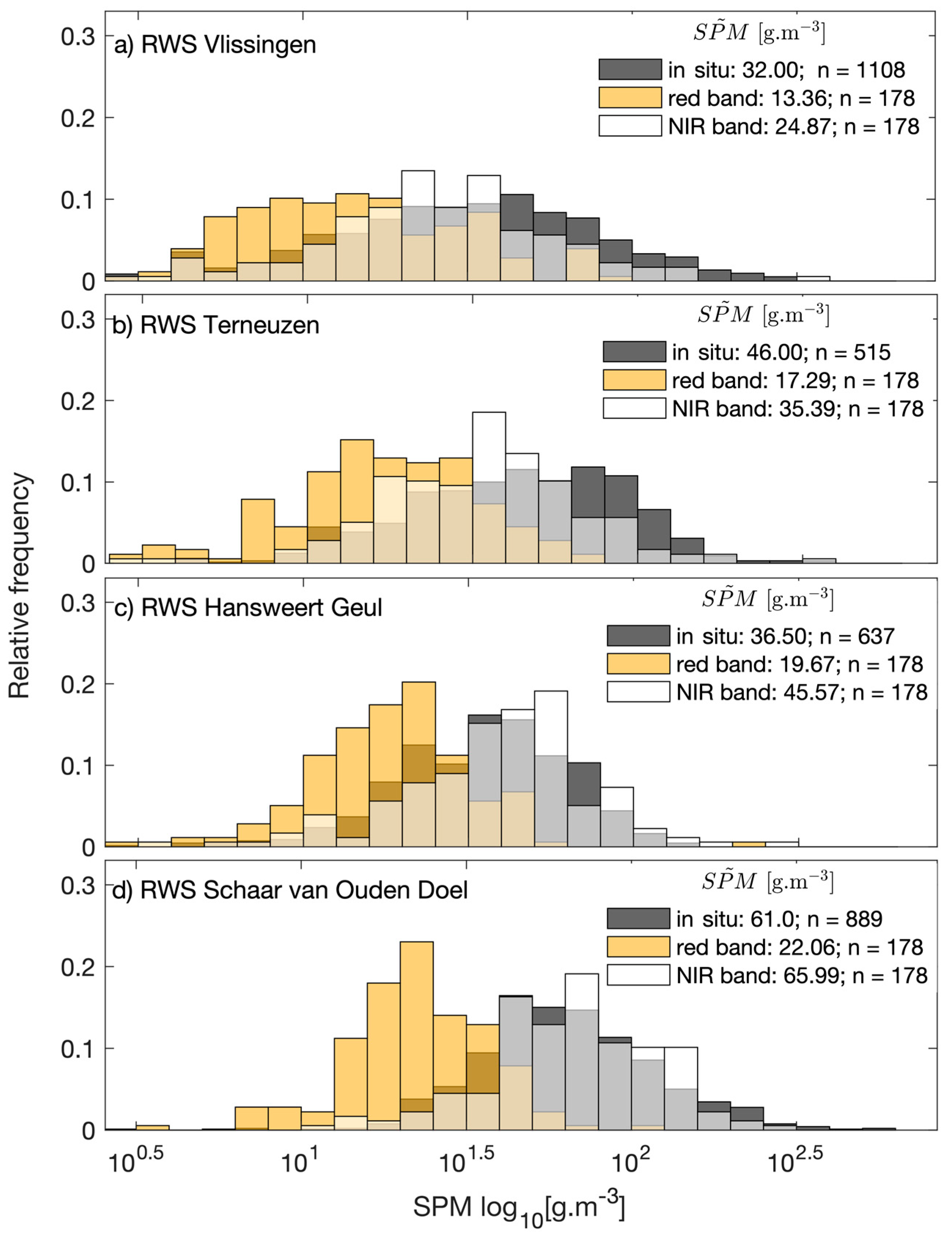
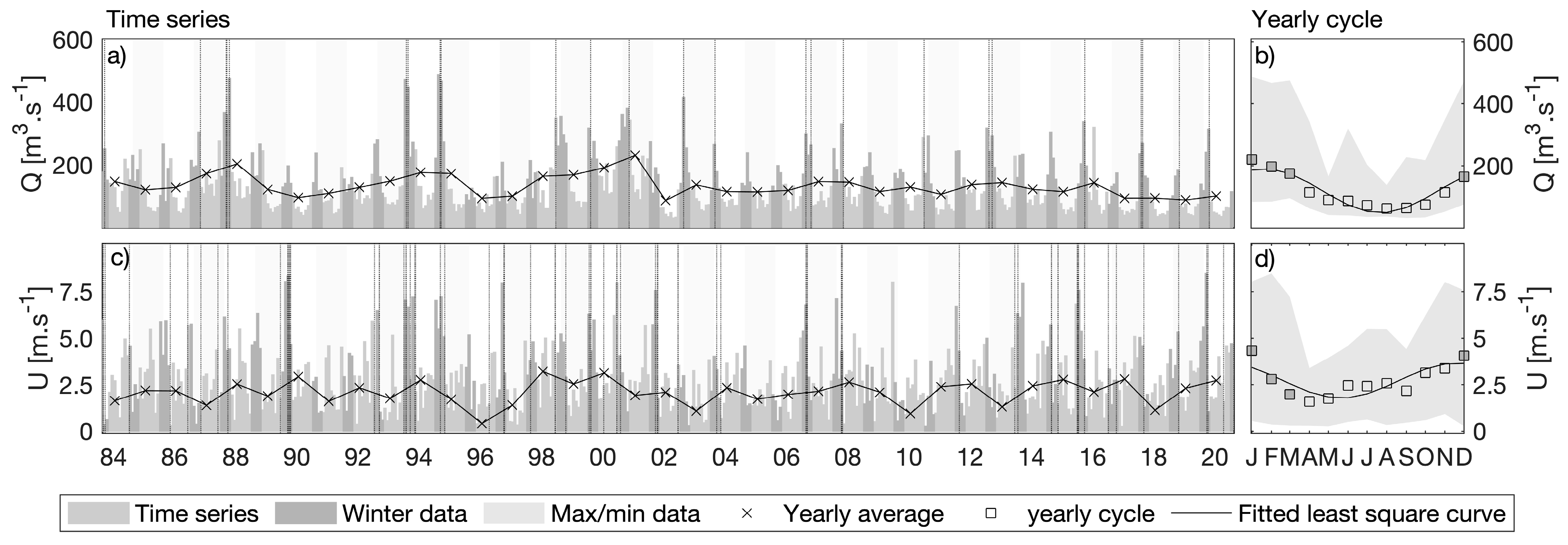
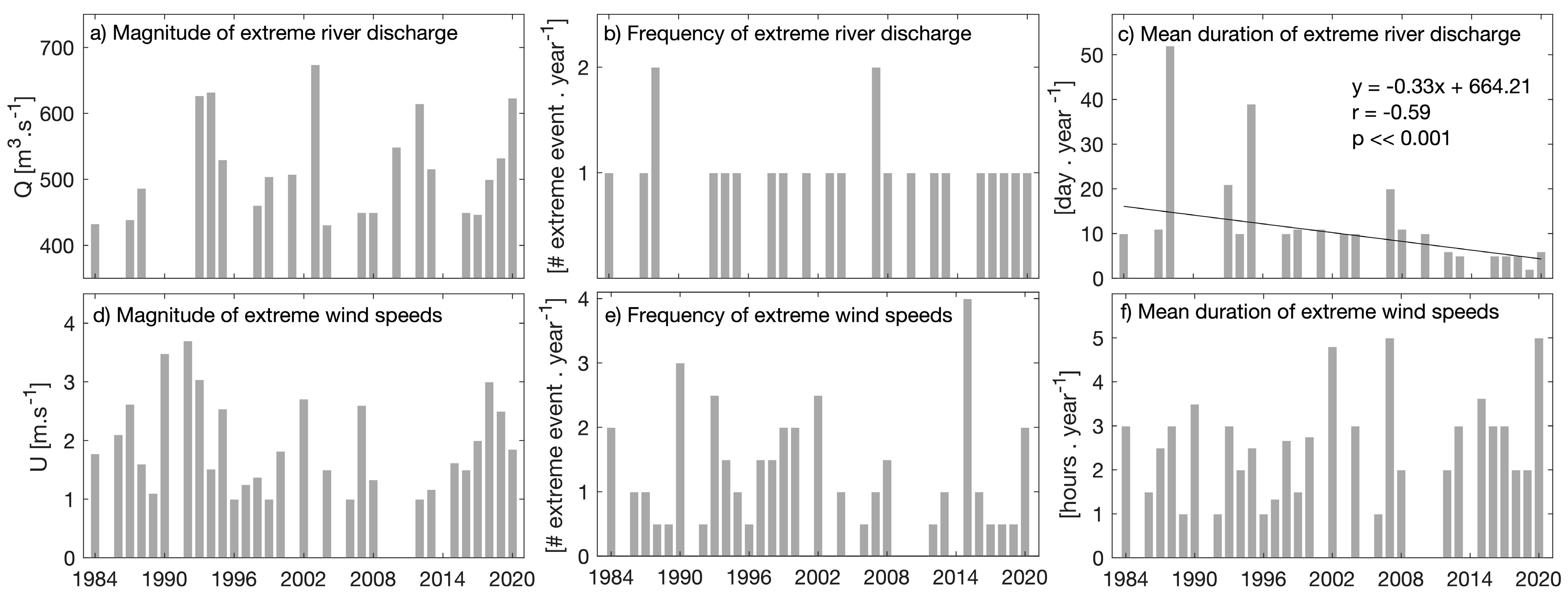
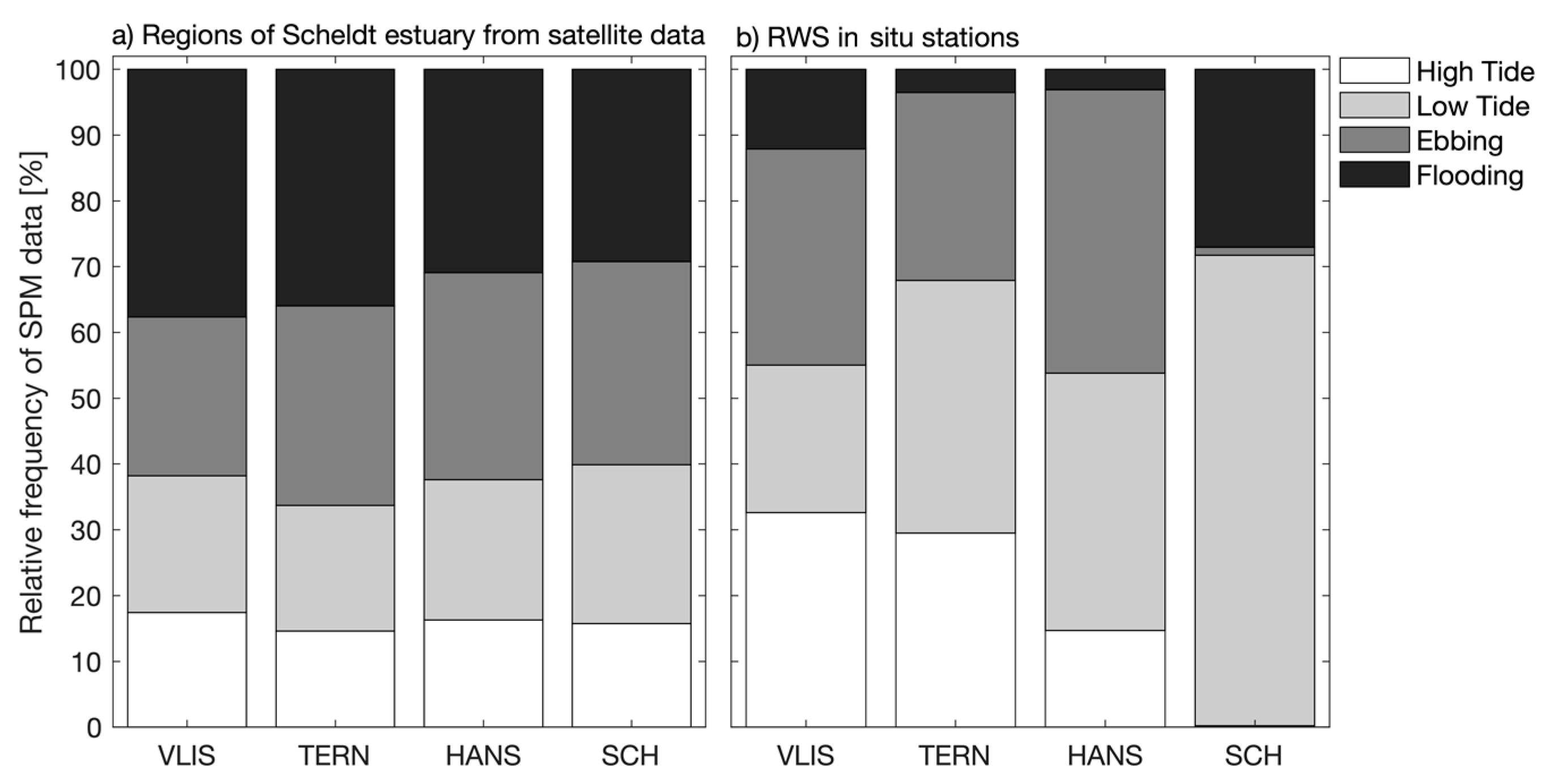
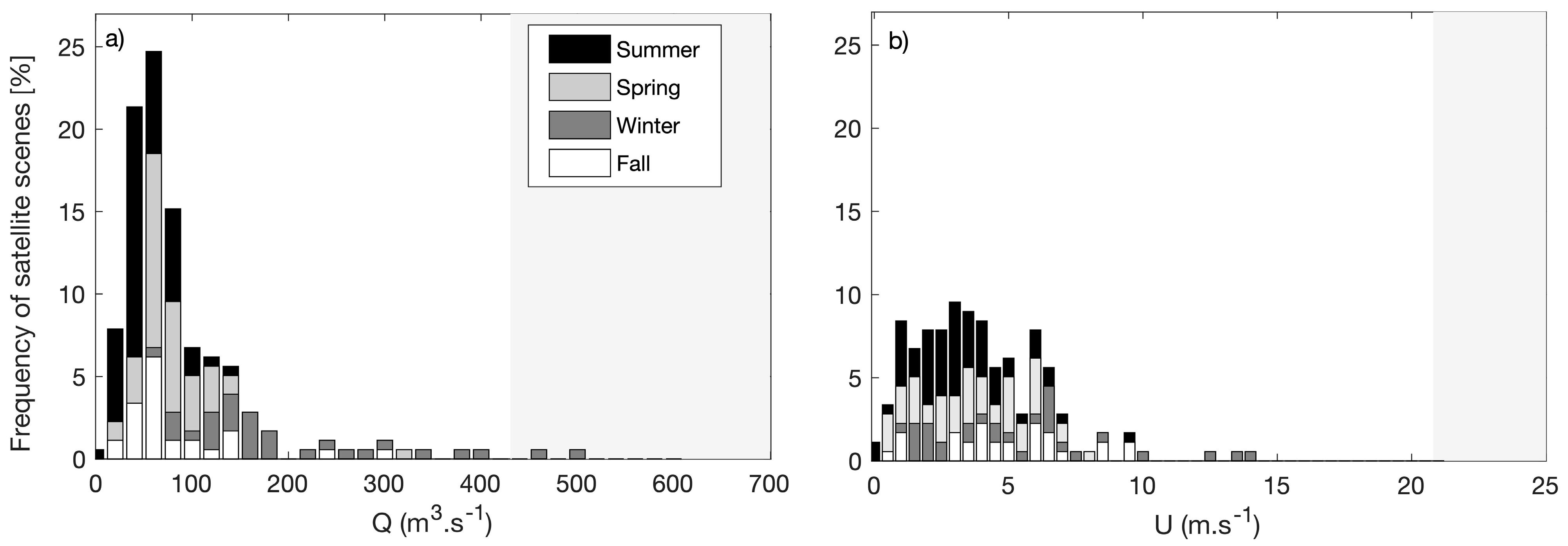
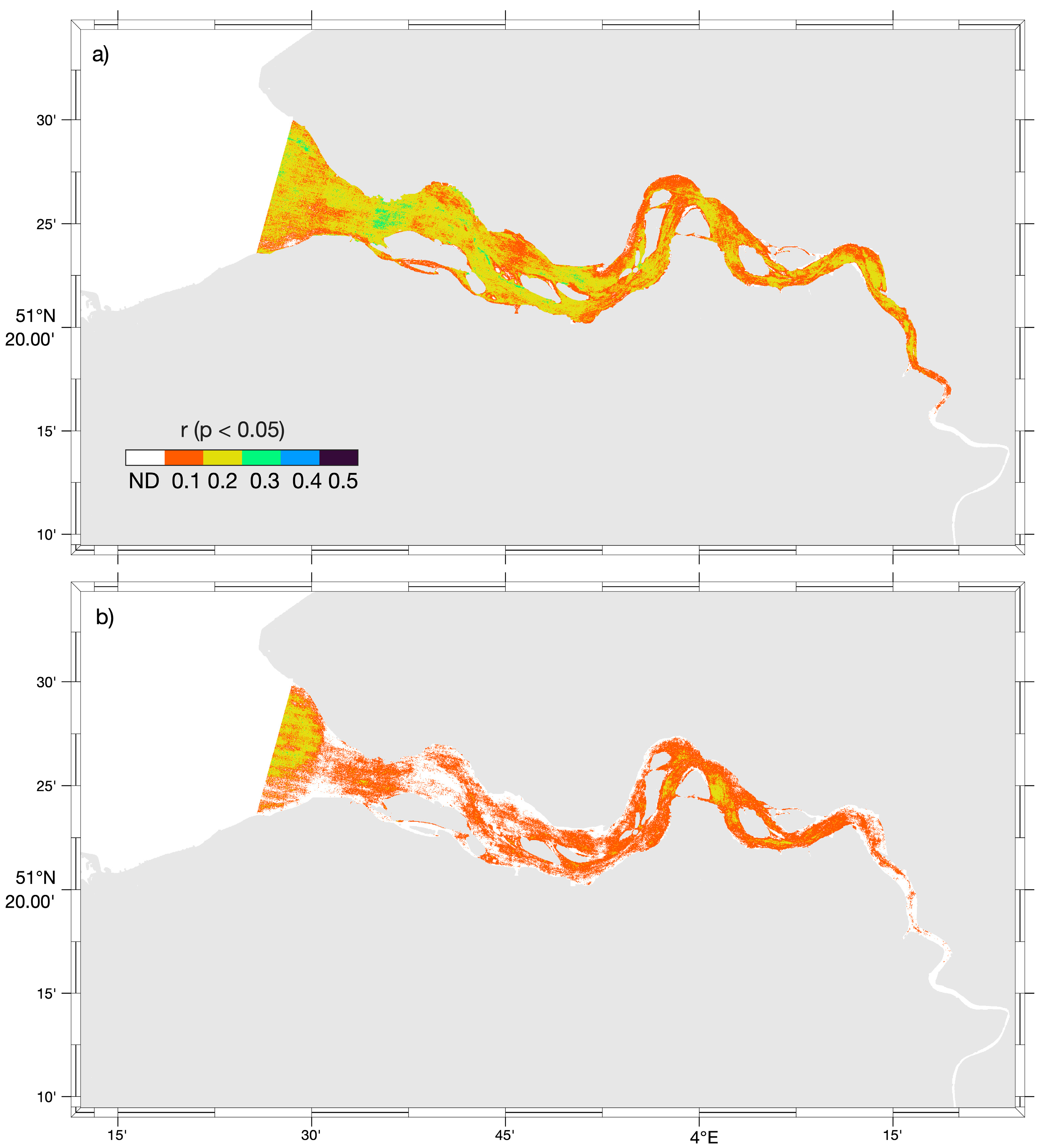

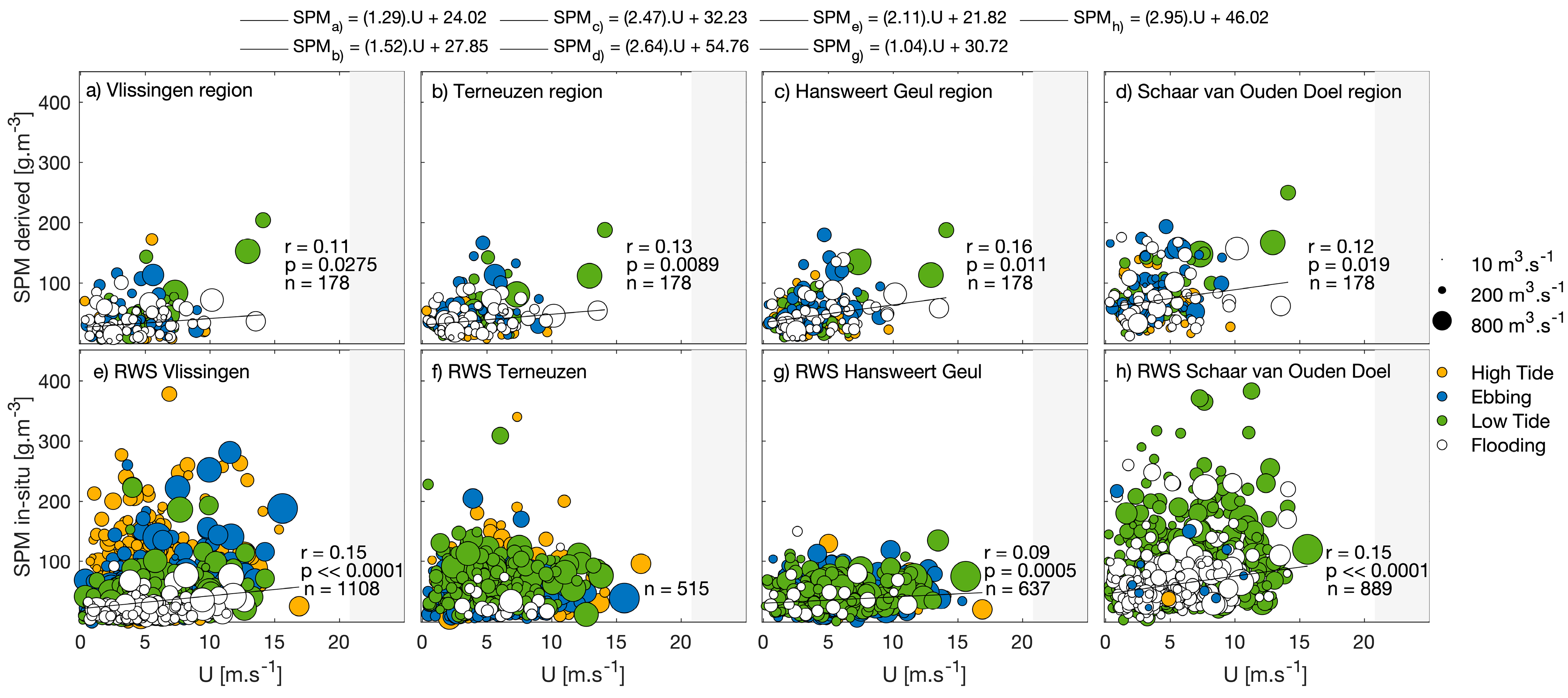
Disclaimer/Publisher’s Note: The statements, opinions and data contained in all publications are solely those of the individual author(s) and contributor(s) and not of MDPI and/or the editor(s). MDPI and/or the editor(s) disclaim responsibility for any injury to people or property resulting from any ideas, methods, instructions or products referred to in the content. |
© 2023 by the authors. Licensee MDPI, Basel, Switzerland. This article is an open access article distributed under the terms and conditions of the Creative Commons Attribution (CC BY) license (https://creativecommons.org/licenses/by/4.0/).
Share and Cite
Tavora, J.; Salama, M.S.; Penning de Vries, M.; Mannaerts, C.M.; van der Wal, D. Detecting the Effects of Extreme Events on Estuarine Suspended Particulate Matter Using Satellite Remote Sensing (Scheldt Estuary): Challenges and Opportunities. Remote Sens. 2023, 15, 670. https://doi.org/10.3390/rs15030670
Tavora J, Salama MS, Penning de Vries M, Mannaerts CM, van der Wal D. Detecting the Effects of Extreme Events on Estuarine Suspended Particulate Matter Using Satellite Remote Sensing (Scheldt Estuary): Challenges and Opportunities. Remote Sensing. 2023; 15(3):670. https://doi.org/10.3390/rs15030670
Chicago/Turabian StyleTavora, Juliana, Mhd. Suhyb Salama, Marloes Penning de Vries, Chris M. Mannaerts, and Daphne van der Wal. 2023. "Detecting the Effects of Extreme Events on Estuarine Suspended Particulate Matter Using Satellite Remote Sensing (Scheldt Estuary): Challenges and Opportunities" Remote Sensing 15, no. 3: 670. https://doi.org/10.3390/rs15030670
APA StyleTavora, J., Salama, M. S., Penning de Vries, M., Mannaerts, C. M., & van der Wal, D. (2023). Detecting the Effects of Extreme Events on Estuarine Suspended Particulate Matter Using Satellite Remote Sensing (Scheldt Estuary): Challenges and Opportunities. Remote Sensing, 15(3), 670. https://doi.org/10.3390/rs15030670






